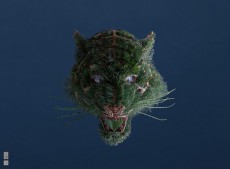Craft Curiosity Issue :「伝えたいメッセージに固定されすぎず、素材によって提示されたままに作る自由さを持つこと」Interview with Raku Inoue
NeoL / 2020年5月31日 17時0分

フィジカルな距離を求められる今、オンラインに没入する時間が増加傾向にある。情報収集や人との繋がりはもちろん大切だが、同時に自身を落ち着いたオフラインの環境に置くこともまた重要だ。自分が求めるものや喜びを感じるものを、己の手を動かして創り上げる時間は、長期戦が見込まれるこのニューノーマルを生き抜くための術でもある。NeoLではハンドメイドのアートで人々を魅了する作家の作品を紹介するとともに、ものづくりの時間へ誘う。
花や植物を用いて昆虫や動物を形づくるアーティスト、Raku Inoue。日本で幼少期を過ごし、モントリオールで暮らす彼にとって、自然は常に心惹かれる対象だった。グラフィックデザインなどを学んだのちにたどり着いたいまのアートの形について、素材への敬意についてなどを聞いた。
(→ in English)
ーー植物、花を用いた創作を始めたきっかけを教えてください。
Raku : ある風の強い日、裏庭のバラの花びらが吹き飛ばされて地面に落ちていました。それを拾って、最初の“花の昆虫”となる小さなカブトムシを作ったんです。祖母とカブトムシを捕まえていた日本で育った子ども時代から、昆虫には愛着がありました。また、好奇心を養ってくれる百科事典を読んで素晴らしい時間を過ごし、植物や昆虫など、この惑星に存在する多くのことについて学んだ記憶もずっと残っています。ですから、昆虫や花に引き寄せられ、インスピレーションを得るようになったのはごく自然なことだと思います。
ーーどうしてそのような素材を選んだんでしょう。
Raku : 私は生きているものが大好きなんです。短い時間しかもたないのでうまく作業することは難しいのですが、出来上がったものは本当に素材のフレッシュさをまとっているんです。それはまた、私が自然と調和しているようにも感じさせてくれます...まるで自分の周囲の環境とハーモニーを奏でているような、ものすごく豊潤な感情を得ることができるんですよ。
ーー形成やカラーリング、固定方法など基礎知識/技術はどのようにして習得されましたか。
Raku : 美術の授業で基本的なスキルを学びましたが、今の知識のほとんどは学校の外から学んだものです。私は非常に好奇心が強く、さまざまな技術を常に試し、心地よい場所から外に出て冒険をしていました。
ーー最初に作った作品はどのようなものでしたか。また今振り返って自身にどのようなアドバイスをしたいですか。
Raku : 最初の"花の昆虫"の一つは、私がミントの葉と花を使って作ったトンボです。トンボは、私にとって常に象徴的な生き物でした。幼少期を過ごした日本では、毎年夏になると、祖母が窓を開け、トンボが家の中を飛んでいました。祖母は、いつもトンボは亡くなった祖父の生まれ変わりで、私たちを訪れては彼が私たちを見守っていたことを知らせているのだと言っていました。"花の昆虫"を作ったのは計画してやったこととではないので、何かアドバイスをすることは難しいです。そこから今のようにものづくりができていることは本当にありがたいことだと思います。

ーー作品の中にご自身の“核/個性”をどのような形で表現されていますか。
Raku : それは、作っているものと、伝えようとしているメッセージがあるか、それがどんなものかによります。意味や深いメッセージのないアートを作ることもいいし、非常に健康的なこと。もっと意味のある作品を作るときは、コンセプト全体を考えすぎないようにします。わかりやすいメッセージとそれに伴うヴィジュアルを使用し、シンプルさを保つようにしています。
ーーその“核/個性”を作り上げたプロセスを教えてください。
Raku : うーん、これは短く答えるのがとても難しい質問です。私にとって、プロセスは生涯をかけて巡る旅であり、いいと思うものも時間とともに変わる可能性があります。だから私は、単に人生を生き、そこから学ぶと答えるしかない。何年も前、青年の頃、私は自分のことをもっと知るための旅として日本に戻ってきましたが、それは自分の価値観に大きな影響を与えました。北海道のジャガイモとトウモロコシの農場で働く機会があり、農民の方々の大変な仕事の内容に感謝することを学びました。太陽の光のさす屋外で、早朝のさわやかなそよ風とともに過ごしました。その仕事では自分の周囲、つまり自然と同調して調和することはありませんでしたがね。
ーーモントリオールと日本(特に広島)の自然、特に植物にはどのような違いを感じていらっしゃいますか。
Raku : 日本の蒸し暑い夏と比較すると、ここモントリオールの夏はとても過ごしやすく、あたたかいという感じです。日本から引っ越してから2回くらい夏を迎えるまでは汗もかかなかったくらいです。日本には松の木で覆われた山がたくさんあることを覚えています。カナダ東部の土地ははるかに平坦で、秋になると木の葉の色が緑から赤、オレンジに変わります。この季節のローレンシア高原は特に観光客に人気です。


ーーグラフィックや粘土から植物を用いたスカルプチャーに移遷したプロセス、そして培ったグラフィックや粘土の技術や知識の活かし方を教えてください。
Raku : 粘土を用いることによって、被写体を立体で見ることができ、光と影についてもより深く理解することができました。それまでは3Dで何かを描くのは難しいことでした。また、視点の法則の理解にも非常に役立ちました。グラフィックデザインの知識は、学校で習得した中で最も価値のあるものの1つです。グラフィックの感覚はどこにでも適用でき、すべてのアートフォームに適用できます。それは見る人と対象物の関係の構造とそのメカニズムを理解することであり、とても魅力的なテーマです。
ーー折り紙や生け花からもインスピレーションを得ているそうですが、それを自身の中でどのように昇華して、自分の作品の落とし込んでいますか。
Raku : 私の叔母は生花と茶道を教えていました。彼女が花をとても美しく優雅に見せるためのスキルと技術を見せてくれたことを覚えています。素晴らしく魅了されました。折り紙には予想、準備が必要です。プロジェクトに適した厚さ、色、質感、種類の紙を選ぶことが重要。ひとつひとつのステップが大切で、今のステップが成功しないと次がダメになってしまう。それは生け花という芸術の基本と同じなのです。適切な材料を選び、充分に用いて、それらをアートワークに変えていくというね。
ーー色彩もとても特徴的ですが、どのようなバランスを考えられていますか。
Raku : 色に関して私が言うことはありません。私はプロジェクトをコントロールしすぎないようにしています。つまり、すべてを完璧に調整しようとするよりも、素材を輝かせたいと思っているんです。したがって、色、形、サブジェクトなどすべての要素は、素材自体から示唆されるものであり、私はそれらを使ったにすぎません。夏の間と冬の間でクリエイションが違うのは、2つの季節に見られるものが全く異なるからで、それが季節感を与えているのだと思います。
ーー自然の素材だけを用いての制作で、着色や色加工などは行なっていないとのこと。花や植物を見て創作するものを決めるのか、逆に創作する対象を決めてそれに合わせて素材を集めるのか、どのような流れが多いですか。
Raku : 素材を探すとき、私はいつも素材を1番、テーマを2番目に置くようにしています。実は型紙も持っていないんです。時々はテーマを示唆してるような作品や取り入れたい具体的なメッセージがあるかもしれません。私にとってこの場合の最も重要な側面は、メッセージに固定されずぎず、(素材によって)提示されたままに作る自由さを持つこと。それはインスピレーションを探すようなもので、強制できるものではありません。私は受け入れ、理解することで、自分の周囲に敏感であり続けることができます。
ーーアイデアの段階から“植物の昆虫”を作るまで、どのようなプロセスを経るのか具体的に教えてください。
Raku : 資料を探すことから始めると同時に、面白いテーマについて考え始めます。この後は、素材で利用可能なものとクリエイティヴのビジョンとの間を往復します。ジグソーパズルを解くのと同じように、適切な場所に適切なピースを見つけ、試行錯誤して磨き上げ、完成するまで繰り返します。
ーーその過程で最も難しいところは?
Raku : “植物の昆虫”は難しいものではありませんでした。これらの花の作品を作ることはいつも私にとってセラピーのようなものだと気づいたんです。生花と同じように、チャレンジや段階はありますが、すべてのアートのコンセプトは、自然と調和し、その利点を取り入れながら、パーソナライズされた方法で表現して他の人も楽しむことができるようにするというものです。
ーーデジタル処理で形状を作ることやご自身で堆肥を作るなど、自然の素材を無題にしないような努力もされています。他に素材への配慮としてどのようなことをされているか教えてください。
Raku : 自然をケアする方法はたくさんあります。何もしないよりは何かした方がいい。自分の植物、花そして野菜を育てることはあなたとあなたのコミュニティに大きな意味で役に立ちますし、有毒な廃棄物を減らし、不必要な消費を制限することもできます。


ーーこれから生け花や何か身近にある素材を用いて創作を始めるビギナーに向けて、技術的、精神的なアドバイスをお願いします。
Raku : 始めたばかりの場合は、基礎について考えてください。花はたくさんの種類があり、維持するためのさまざまな方法があります。それらを研究し、自分独自の持ち味を大切に。素材にきちんと尊敬の念を持つことを学んだ後に、ようやく自分のアイデアやテクニック、そしてそれら作品に適用する方法について考えることができると思います。
ーー材や道具の購入にオススメのメーカー/オンラインショップがあれば教えていただけますでしょうか。
Raku : 地元の花屋でもいいですし、私が用いる素材のほとんどすべては自然の至る所にあります。外に出て、何を見つけられるかやってみてください。でも覚えておいて欲しいのは、持っていないものを追いかけるのではなく、自分が手に入れられて利用できる材料をどのように使うかが重要なんです。この観点を持つことで、私たちは状況に適応することを学び、創造的なプロセスに関してより柔軟になることができます。
ーー新型コロナウィルス感染症(COVID-19)でクリエイティヴ面にどのような影響が出ていますか。
Raku : 幸い、隔離前とさほど多くの変化はありません。クライアントのほとんどはさほどの支障なくオンラインに切り替えることができたようです。それらもこの困難な時を乗り切るために、適応していく術ですね。
ーーこの側面で新たに気づいたこと、やってみたいアイデアがあれば教えてください。
Raku : この夏はもう少し過ごししやすくなりそうです。通常だとこの時期は仕事に忙しいのですが、現在の状況に合わせて優先順位をリセットしようとしています。生活をすること、時間をかけていまの時を心に刻むことに集中したい。
ーー事態が好転し、COVID-19が収束したらしたら何をしたいですか。
Raku : モントリオール東部の田舎でロードトリップを計画しています。毎年行なっていて、それができないのは非常に辛い。見ること、体験することがたくさんあり、その小さな冒険に出るのが待ちきれません。
ーーニュースなどお知らせがあればお知らせ下さい。
Raku : 最近は芸術性とデザイン性が非常に優れたフードマガジン「Fool Magazine」と仕事をしています。彼らの次の号は、日本とその料理の世界をテーマにしていて、その中で私は世界的に有名な3人のシェフ、Sean Brock、Andoni Luis Aduriz、そして最後に東京のInuaで料理長を務めるThomas Frebel のテキストにイラストを添えています。彼らは皆、日本の食べ物や文化への憧れについて書いており、彼らの文章に自分の作品を添えることをとても光栄に思います。自分にとっても料理の世界への素晴らしいデビューとなりました。長い間、私はこれらのシェフの料理への愛情と彼らが食材に対して抱いている尊敬を反映するアートワークを作りたいと思っていました。彼らの芸術との関係性は私のそれととても近しいと思います。自然が私たちに提示するものを優雅に受け入れ、他の人が楽しむことができるようにそれらを独自方法で解釈するというね。
Raku Inoue
Multidisciplinary artist
www.reikancreations.com
https://www.instagram.com/reikan_creations/


ーーWhat made you want to start creating pieces with plants and flowres?
Raku : One day, it was winding a lot and the fragile petals of roses in my backyard were blown off to the ground. I picked them up and made my first floral insect: a small beetle. The fascination for the crawly creatures is something that goes back to the childhood growing up in Japan where I used to catch Kabutomushi with my grandmother. I also remember spending wonderful time inside encyclopedias feeding the child’s curiosity and learning about many things that exist on this planet including plants and insects. So, after all, I think it was only natural that I am finding myself gravitating towards these subjects for inspirations.
ーーWhy did you stick with the materials that you use currently for your works?
Raku : I just love working with organic materials. Being that they are ephemeral, it is a challenge to successfully work with but the final results really capture the freshness of the materials. It also makes me feel in tune with nature...like I am in harmony with my surrounding..it is a very liberating feeling.
ーーFrom sharping, colouring to molding , how did you acquire the necessary basic knowledge and skills for your creations?
Raku : I learned the basic skills in art classes but most of what I know now was learnt from outside school. I was very curious and constantly experimenting with different technics and venturing out of my comfort zone.

ーーWhat was one of the first things you made? Looking back, what kind of advice would you give yourself?
Raku : A dragonfly I made using mint leaves and flowers was among the first floral insects I have ever made. This flying insects has always been a symbolic creature to me: Every summer my grandmother would open the windows and a dragonfly would fly inside the house. My grandmother always said that it was a reincarnation of her deceased life-partner visiting us and letting us know that he was watching over us. I can't really think of a specific advice to give to myself since making floral insects was not something I planned in advance. I am just very grateful that things turned out this way.
ーーHow do you personally express your core/personality/values through your work?
Raku : It depends on what I am creating and the message I am trying to convey if any. Making art without any meanings and deeper message is totally fine and can be tremendously therapeutic. When I create a more meaningful piece, I try to avoid overthinking the whole concept. I try to keep it simple with a clear message and a visual to accompany.
ーーCould you take us through the process you underwent to build that core/personality/value ?
Raku : Hmm this is a very hard question to answer in few paragraphs...for me, the process is a life-time journey and things that you stand up for can change with time.
So I would answer that simply living life and learn from it. Many years ago in my young adult days, I have travelled back to Japan as a self-searching journey and it had a huge impact on my value. I have had the chance to work in a potato and corn farm in Hokkaido and there, I have learnt to appreciate the hard work of a farmer-life. Being outdoor under the sun and with the fresh breeze of the early morning. I never felt in tune and in harmony with my surrounding: nature.


ーーComparing the nature and especially the plants in Montreal and Japan(Hiroshima), what are you some differences that you have come across?
Raku : Comparing to the hot and humid summer of Japan, The summer here in Montreal is just nice and warm. It took 2 summers after I have moved here from Japan before I started actually sweating. I remember that Japan has many mountains covered with pine trees, The land in the eastern Canada is much more flat and during autumn the colours of the tree leaves changes from green to red and orange. The Laurentians is particularly popular for tourists during this seasons.
ーーYou shifted from graphics and clay to creating sculptures with plants. Can you tell us how that shift occurred and how you were also able to apply the knowledge and the skills from graphics and clay to what you do today?
Raku : With clay I was able to see a subject in 3D and gave me a deeper understanding in term of lights and shadows. Before this, it was a challenge for me to draw anything in 3D. It was also very helpful understanding laws of perspectives as well. Graphic designs was one of the most valuable knowledge that I have acquired in school. Sense of graphics can be applied everywhere and all art forms can benefit from it. It's about understanding the structure and their mechanics in relation with the audience. Very fascinating subject indeed.
ーー I have read that you get inspiration from Origami and Ikebana. How did these inspirations develop and how were they applied to your own works?
Raku : My aunt used to be an Ikabana and a tea ceremony teacher. I remember seeing her display her skills and techniques to make flowers appeal very beautiful and elegant. Even if I couldn't put it down in writing back then, I was very much fascinated. With origami, you need a sense of anticipation...Choosing the right type of paper with the right colour and the right texture with the thickness appropriate for the project is crucial. Each step is important and the success of the current step is mandatory for the next following step. It is the same basics with the art of ikebana: Choosing the right materials and amply them to turn them into an artwork.
ーーThe colour palette in use amonget your works is very uniquel as well. In terms of colour, in your opinion how would you define balance?
Raku : This is something that I don't really have a say on. I try to keep my ownership on the control of the project in check. In other words, I like to let the materials shine rather than me trying to adjust everything into perfection. Therefore, the colours, shapes and subjects..these are all the factors that are suggested to me by the materials itself and what's available for me to use. The creation that I make during summer is different from winter because of what I can find during these two seasons are completely different and this gives a sense of seasonality.
ーーYou do not use any artificial colouring and only use natural materials in your works.Do you observe the flowers and plants first and decide what to create or -choose the subject of your creation first and then start gathering materials for it? Can you take us through your creative process?
Raku : When foraging for materials, I always try to put the ingredients first and the subjects in second and I don't really have a set template. Sometime, its the ingredients that are going to suggest the subject and other time, I might have a specific message I wish to incorporate into the artwork. The most important aspect of this for me is to have the freedom of doing things as it presents to me. Its like searching for an inspiration..it's not something I can force..I can only be receptive and remain sensitive to my surroundings.
ーーFrom ideation to when it is released as well as the Natura Insect could you take us through the whole creation process, start to finish?
Raku : I start by searching the materials and at the same time, I would start thinking about an interesting subject. After this, it's a back and forth between what's available in term of materials and my creative vision. Similarly to solving a jigsaw puzzle, it's all about finding the right piece for the right place and rinse and repeat until completion.
ーーWhat was the most difficult part of it ?
Raku : These Natura Insects were never meant to be difficult. I have always found that making these floral creations was like a therapy to me. Just like Ikebana, there are challenges or course but the whole concept of the art is to be in tune with the nature and taking in all the benefits while expressing it in a personalized manner so that others can enjoy as well.


ーーYou create structure digitally, create your own compost and make a lot of effort to make sure that natural materials are never abandoned. Can you tell us some other ways we can take care of our nature materials properly?
Raku : There are many ways to take care of nature. In fact, anything you can do is better than nothing. Growing your own plants, flowers and even vegetable can benefit you and your community in a big way. Reducing toxic wastes and limiting unnecessary consumption will also help.
ーーFor people just starting out with Ikebana or trying to create something with the materials they have at hand, what kind of advice would you give them mentality and technically?
Raku : If you are just starting out, think about the basics. Flowers are varied and they have many different ways to maintain their livelihood. Study them and respect your ingredients. After you have learned to give the ingredients the respects it deserves, you can think about your ideas and techniques and how to apply them onto your creations.
ーーIf you have any online shops/makers that sell or provide materials and tools that you would recommend, please share them.
Raku : Any local flower shop would do but nearly all of my supplies can be found throughout nature. Just go outside and see what you can find. Remember, its about how you use the materials that are available to you rather than running after the things you don't have. From this perspective, we learn to adapt to the situations and we become more flexible in term of creative processes.
ーーHow has the spread of coronavirus effect your lifestyle and creative activities?
Raku : Fortunately, not too many changes regarding to how things were pre-quarantine. Few clients did undergo radical changes but it seems that many of them was successfully able to go online for the time being. Those that are going to adapt will be the ones that will survive these hard times.
ーーDo you have anything you want to challenge yourself on?
Raku : It would be to take thing easier this summer. Usually, I would be very busy with work around this time of the year but with the whole situation right now, I try to reset my priorities. Taking the time to live and being mindful of the present is something I am trying very hard to do.
ーーAfter the coronavirus converges and the situation gets better, what would you like to do?
Raku : We are planning a roadtrip east Montreal in the countryside. It's out yearly tradition and not being able to do that is very painful. There so much to see and experience out there and we can't wait to go on our little adventure.
ーーAny news or something up and coming that you would like to share with us?
Raku : Recently, I have worked with Fool Magazine, a food magazine with a very strong artistic and design sense. Their next issue is themed about Japan and its culinary world. In it, I will be illustrating the text from three world famous chefs: Sean Brock, Andoni Luis Aduriz and last by not least, Thomas Frebel which is the head-chef at Inua in Tokyo. They all wrote about their admiration of Japanese food and culture and I feel very honoured to be able to illustrate their texts. This was also a great debut for myself into the culinary world. For a long time, I have been wanting to illustrate artwork that reflects these chef’s love for cooking and the respect they hold for the ingredients. When I really think about it, their affinity towards their art runs parallel to mine: Graciously accepting what nature offers us and interpreting them in a personalized manner so that others can enjoy.
Raku Inoue
Multidisciplinary artist
www.reikancreations.com
https://www.instagram.com/reikan_creations/
関連記事のまとめはこちら
https://www.neol.jp/art-2/
この記事に関連するニュース
-
「お願いします」って英語でなんて言う? 依頼表現17選 - 「今年もよろしく!」の英語フレーズも!
マイナビニュース / 2025年1月3日 10時30分
-
tHE GALLERY HARAJUKUにて、2025年1月2日(木)より、THEKLA KAISCHAURI個展「FRACTURED」を開催。
PR TIMES / 2024年12月25日 14時45分
-
UESHIMA MUSEUM ANNEX オープンのお知らせ ~ 2025年1月15日より、今津景展を開催
PR TIMES / 2024年12月23日 15時15分
-
Shareholder Proposals to Japan Business Systems, Inc.
PR TIMES / 2024年12月22日 14時40分
-
この英語ってどんな意味?「apple of my eye」
OTONA SALONE / 2024年12月22日 7時0分
ランキング
-
1妹の結婚相手は“誠実そうな男”だったのに…「泣きながら逃げてきた」妹が明かした恐ろしい素顔
日刊SPA! / 2025年1月15日 15時52分
-
2「太らないパンの食べ方」を、“パン中毒”だった保健師が教えます:1月に読みたい記事
女子SPA! / 2025年1月16日 8時45分
-
3「友達がいない」「こだわりが強い」結婚できなかった37歳男性、それでも“親友のような妻”と出会えたワケ
日刊SPA! / 2025年1月16日 8時54分
-
4食べ過ぎかも? 胃もたれの原因と長引くときの解消方法
マイナビニュース / 2025年1月16日 10時0分
-
5サイゼ「価格据え置きで営業最高益」に見る大変化 逆張り戦略でファストカジュアル化が成功か?
東洋経済オンライン / 2025年1月16日 8時40分
記事ミッション中・・・
記事にリアクションする
![]()
記事ミッション中・・・
記事にリアクションする

エラーが発生しました
ページを再読み込みして
ください










